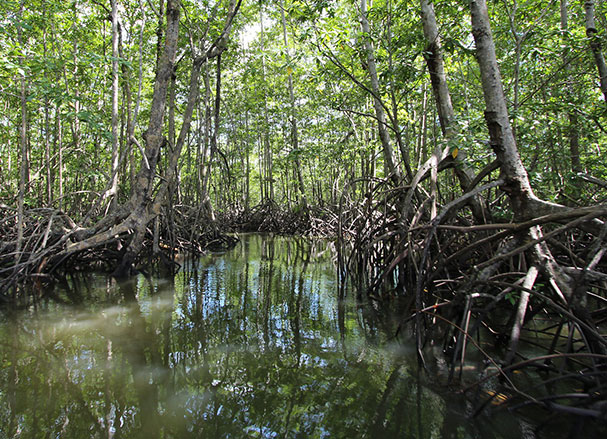The Sierpe River originates from deep within the vibrant jungles at the northeastern edge of the Osa Peninsula. The river snakes its way 48 km (30 miles) out to the Pacific Ocean in a maze of winding, interconnected stream channels that lend it the name “Sierpe,” which means “serpent” in Spanish. By the time it reaches the ocean, the Sierpe River spreads out to more than a kilometer wide. Both the Sierpe and Terraba rivers meander their way to the sea through the Terraba Sierpe National Wetlands (Spanish: Humedal Nacional Térraba-Sierpe), the largest contiguous mangrove forest in Costa Rica and one of the largest of Central America. Six species of unique salt-tolerant trees form the peaceful mangrove forests that are home to a diversity of birds, mammals, insects, amphibians, reptiles, and fishes.
A wild and winding river
Sierpe River
“
The Sierpe River is the gateway to adventure in
the Osa Peninsula. Whether you are in search of surfing,
kayaking, culture, hiking, fishing, or wildlife viewing,
you are sure to find it here.
The town of Sierpe separates the headwaters from the lower reaches of the river about 12 miles inland from the river mouth, or “boca del río” in Spanish. Despite its remoteness, the town of Sierpe is frequented by tourists who come to see the mangrove forests and by Osa locals stocking up on supplies. It is also essentially the “end of the road” for most travelers to the northern Pacific side of the Osa Peninsula. Some visitors stay in Sierpe to explore the local mangrove forests by kayak or boat, visit the cultural museums, or take one of the nature tours. However, to explore the reefs, secluded beaches, and pristine jungles of the Osa Peninsula, visitors need to take a river boat from Sierpe to stay at one of the remote eco lodges such as Casa Roja, where people spend a week adventuring to Caño Island, Drake Bay, and Corcovado National Park.
Even though both are very remote, the mouth of the Sierpe River is quite different from its forested headwaters. Downstream from the town of Sierpe, the river widens meanders through sandbars and expansive mangrove forest. Closer to the ocean, the river sometimes flows in the opposite direction on an incoming tide. As the tides recede, incoming swells can create choppy conditions at the mouth of the river, but local captains are experts at crossing “la boca.” The Sierpe River is the gateway to adventure in the Osa Peninsula. Whether you are in search of surfing, kayaking, culture, hiking, fishing, or wildlife viewing, you are sure to find it here.


